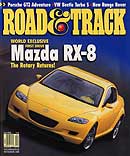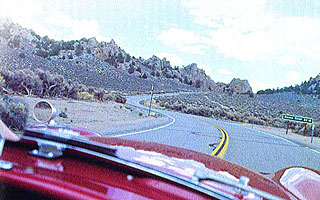Fifty miles down the road, the exhaust note suddenly got loud and obnoxious. Tom shook his head. “It’s the front left gasket at the bottom of the exhaust header,” he said. “It was blown out when I test drove the car two months ago and we had it replaced. I’ve got some spare gaskets in the glovebox.” We pulled off at 5-Star Muffler Express in Manteca, and a man came outside and glanced at the car. “MG, eh? I don’t think we’ve got the tools to work on it.” “No, it’s a Cobra,” Tom said, “with a 289 Ford engine.” “Well, bring it in then and we’ll take a look.” With the car up on the hoist, I had my first good look at the underside of a Cobra: four discs, independent rear suspension with fabricated steel lower A-arms, two big round chassis tubes with welded-on outriggers to support the body, the differential bolted into the rear box section that also supports the transverse leaf springs. All very straightforward, neat and tidy. Rather elemental next to the E-Type chassis I’d just reassembled, but a little friendlier and simpler, with a reassuring heft to the components. The mechanic pointed out that the threads on our lower manifold studs were in poor shape, so they couldn’t snug the gasket down as tight as it should be. We decided to take our chances and drive on. When we finally got off the busy four-lane roads, headed toward Yosemite, Tom pulled over to let me drive on our first open stretch of two-lane road with real curves. All righty, then. The first thing that strikes you about driving a Cobra is how “normal” it is. The clutch is moderate-to-light; the T-10 Borg-Warner gearbox moves through its gates with a pleasant, easy click; the unboosted 4-wheel Girling disc brakes are perfectly linear—they don’t require heavy pressure, but the harder you push, the harder they stop. The steering is light and “natural.” Devoid of quirks, it turns in nicely and unwinds with normal self-centering effort. Ride, too, is surprisingly middle-of-the-road. Tom’s car was not equipped with the optional factory anti-roll bar package, but stayed dead flat in corners, with tons of grip and remarkably civilized compliance over bumps and dips. In short, there’s nothing fussy, cranky or odd about the car. It would have answered all the 1960s’ American expectations for how an automobile should operate—a set of standards that were quite highly developed by then. The only real hair-shirt aspect to the car is its Erector Set top and side curtains. Otherwise, it’s like driving a Mustang with a lightweight English chassis, which you might expect. Overall, I guess I was expecting more kit-car crudeness out of this rather quickly developed Anglo-American hybrid, but instead it’s a car of considerable finesse and refined ergonomics. The people who joined the two halves of its soul knew what they were doing. There are no unsightly seams. The other half of the Cobra’s soul, of course, is the 289 Ford engine, the solid-lifter, 4-barrel K-Code version lifted right out of the High Performance Mustang. It would be fun to say this engine provides stupefying levels of acceleration that make you bleed from the ear, but that would probably be more true of the 427 Cobra. The 289 is merely torquey, instantly responsive and very fast. Our R&T road test from June 1964 produced a 0–60 time of 6.6 seconds, a quarter mile of 14.0 sec. at 99.5 mph and a projected top speed of 139 mph at 6900 rpm in high gear. The R&T test mentioned that you could achieve 60 mph in 1st gear and 100 mph in 3rd and said our first impression of the Cobra was “one of blinding acceleration in all gears,” adding, “the passing ability of the car at any speed is nothing short of sensational.” Pages 1 , 2 , 3 , Next , 5 , 6 , 7
|

